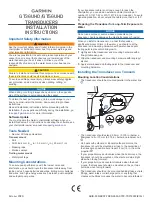
4 - 1
SECTION 4 CIRCUIT DESCRIPTION
4-1 RECEIVER CIRCUITS
4-1-1 ANTENNA SWITCHING CIRCUIT
The antenna switching circuit toggles the receive line and
the transmit line. This circuit does not allow transmit signals
to enter the receiver circuits.
Received signals from the antenna connector (CHASSIS
UNIT; J1) are passed through a two-stage low-pass filter
(LPF; L22, L23, C204–C207, C209) and applied to the
λ
/
4
type antenna switching circuit (D12, D22).
While receiving, no voltage is applied to D12 and D22.
Thus, the receive line and the ground are disconnected and
L41, L42, C199–C202 function as a two-stage LPF which
leads received signals to the RF circuits via the limiter (D20, D21).
4-1-2 RF CIRCUITS
The RF circuits amplify received signals within the range of
frequency coverage and filters off out-of-band signals.
The signals from the antenna switching circuit are passed
through the two-stage tunable bandpass filters (BPF; D18,
D19, L38, L39, C191, C193, C194, C197, C232, C233) to
suppress unwanted signals. The filtered signals are ampli-
fied at the RF amplifier (Q18).
The amplified signals are passed through another two-
stage tunable BPF (D15, D16, L49, L52–L55, C171, C173,
C174, C176) to suppress unwanted signals again. The fil-
tered signals are then applied to the 1st IF circuit.
4-1-3 1st IF CIRCUITS
The 1st mixer circuit converts the received signals into fixed
frequency of the 1st intermediate frequency (IF) signal
by mixing with the local oscillator (LO) signals which con-
trolled by the PLL circuit. The IF is shifted by changing LO
frequency to track the receive signal. The converted 1st IF
signal is filtered at the 1st IF filter, then amplified at the 1st
IF amplifier.
The signals from the two-stage tunable BPF are converted
into the 46.35 MHz 1st IF signal at the double-balanced
type 1st mixer (IC14, L30, L31, L33) by being mixed with
the 1st LO signal generated at the RX VCOs (Q4, D4, D5,
D24, D26 or Q20, D27 to D30).
The 1st IF signal from the 1st mixer is passed through the
crystal filter (FI3) to suppress unwanted signals, and then
amplified at the 1st IF amplifier (Q17). The amplified 1st IF
signal is applied to the FM IF IC (IC3, pin 16).
4-1-4 2nd IF AND FM DEMODULATOR CIRCUITS
The 1st IF signal is converted into the 2nd IF signal and
demodulated at the detector section in the FM IF IC. The
FM IF IC contains 2nd mixer, limiter amplifier, quadrature
detector, etc. in its package.
The 1st IF signal from the 1st IF amplifier (Q17) is applied
to the mixer section in FM IF IC (IC3, pin 16). The applied
1st IF signal is mixed with the 45.9 MHz 2nd LO signal gen-
erated by tripling the 15.3 MHz PLL reference frequency to
be converted into the 450 kHz 2nd IF signal.
The 2nd IF signal from the mixer section is output from pin
3 and passed through the N/W switches (D13, D14) and
ceramic filter (FI1 or FI2) to suppress the heterodyne noise.
The N/W switches (D13, D14) toggle the receive mode
wide and narrow according to “NWC” signal from the CPU
(IC307, pin 19). FI1 is used for wide, and FI2 is used for
narrow mode operation.
The filtered signal is applied to IC3 (pin 5) again, and
amplified at the limiter amplifier section and demodulated
by the quadrature detector.
Mixer
RSSI
Quadrature
detector
1st IF from the IF amplifier (Q6)
16
Noise
detector
5V
X2
11
10
IC3
TA31136FN
Filter
amp.
Limiter
amp.
“DET” signal
to the D/A convertor (IC303; pin 1)
“SQL” signal
from the D/A convertor (IC303; pin 2)
• 2ND IF AND DEMODULATOR CIRCUITS
9
“NOIS” signal to the CPU (IC307: pin 37)
“RSSI” signal to the CPU (IC307: pin 50)
“DFIL” signal to the digital IF filter (FI1: DSP UNIT)
13
12
Q14
X3
15.3 MHz
45.9 MHz
BPF
2
3
Q303
D-IF
8
7
3
5
FI2
FI1
N/W
SW
N/W
SW
D14
D13
Содержание IC-F70DS
Страница 1: ...SERVICE MANUAL VHF TRANSCEIVER ...
Страница 42: ...S 14124HZ C1 2005 Icom Inc ...








































